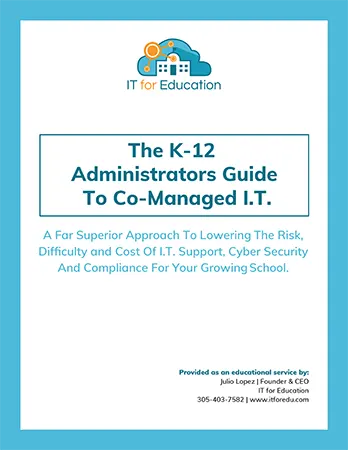
October is Cybersecurity Awareness Month, making it the perfect time for schools to step back and evaluate how well they’re protecting their students, faculty, and community from today’s growing digital threats.
Here’s the reality: Most cybersecurity incidents in schools don’t happen because of elite hackers. They happen because of small, everyday habits. For example, a teacher clicking on a suspicious link, skipping a software update, or reusing a password that’s already been exposed in another breach.
The good news? Small changes in your school’s daily technology habits can add up to big protection.
Here are four cybersecurity habits every school should adopt:
1. Communication
Cybersecurity should be part of your school’s everyday conversation, not just something the IT team worries about.
Talk with your faculty and staff regularly about the digital risks they might face and how to avoid them. For example:
- Share a quick reminder in a staff meeting on how to spot a phishing email.
- Post a notice about a recent scam targeting schools to keep your team alert.
When cybersecurity becomes part of your culture, it feels less like “extra work” and more like second nature.
2. Compliance
Every school has rules and standards to follow! Whether it’s FERPA for student privacy, HIPAA for health records, or local/state regulations around technology and data use. Compliance isn’t just about avoiding fines; it’s about protecting trust within your school community.
Even if your school isn’t governed by strict regulations, parents still expect you to protect their children’s information. Failing to do so can damage both your reputation and your ability to operate effectively.
Make sure to:
- Review your technology and security policies regularly to align with current standards.
- Keep detailed records of cybersecurity training and system updates.
- Treat compliance as a shared responsibility, not just an IT checkbox.
3. Continuity
If your systems went down tomorrow, how quickly could your school get back up and running? Continuity is all about being prepared for the unexpected.
Always:
- Ensure backups are running automatically and tested regularly.
- Have a clear plan for what to do if ransomware locks up your files or student records.
- Identify which systems are essential to classroom operations and prioritize their recovery.
A solid continuity plan helps ensure that learning doesn’t stop, even if technology does.
4. Consistency
Cybersecurity isn’t something you focus on only once a year. It’s built on consistent effort.
That means keeping software and devices up to date, running regular network checks, and reinforcing best practices with your team.
Encourage your staff to:
- Use strong, unique passwords (and consider password managers).
- Report anything suspicious immediately.
- Participate in regular cybersecurity refreshers or short training sessions.
Consistency builds resilience and resilient schools are better equipped to handle digital threats without disruption.
A Secure School Is an Empowered School
At the end of the day, cybersecurity isn’t just an IT issue; it’s a schoolwide priority that keeps students safe, teachers teaching, and classrooms running smoothly.
Building awareness, improving compliance, ensuring continuity, and maintaining consistency are the cornerstones of a secure, connected learning environment.
When every staff member plays a role, cybersecurity becomes less about fear and more about empowerment.
Ready To Put These Habits Into Action?
Cybersecurity Awareness Month is the perfect time to take stock of your defenses and train your team to spot the threats that matter most. Don’t wait until an attack forces your hand.
Schedule a free discovery call today and let us help you build a cyber-smart culture in your workplace.



